Feeds and feeding regimes
Several papers have been published about the food and feeding habits of young and adult greater amberjack (S. dumerili) (Lazzari and Barbera 1988, 1989a; Grau et al. 1992; Mazzola et al. 1993; Badalamenti et al. 1995; Matallanas et al. 1995; Pipitone and Andaloro 1995). It has also been reported (Nikolwsky 1963; Wooton 1991), that S. dumerili undergoes a marked diet shift during its development.
The few commercial farming experiences with S. dumerili in the Mediterranean, as in the case of the Japanese amberjack in other regions, have been based on frozen, low-cost raw fish, e.g. Sardinella aurita, Boops boops, Trachurus trachurus, Scomber scombrus, Engraulis encrasicholus and Sardina pilchardus. Many research studies about the on growing of S. dumerili in tanks and in cages have used raw fish as food (Giovanardi et al. 1984; Navarro et al. 1987; Cavaliere et al. 1989; Lazzari and Barbera 1989b; Grau 1992; Boix, Fernandez and Macia 1993; Garcia 1993a; Garcia, Moreno and Rosique 1993; Greco et al. 1993; Porrello et al. 1993, Mazzola et al. 1993). Greater amberjack seems to find fish scraps more appetising than pellets (Mazzola, Favaloro and Sara 2000). Fish fed ad libitum with raw fish have a food conversion rate (FCR) of 5-7:1. Growth and feeding parameters in greater amberjack are
influenced by fish age and water temperature (Garcia 1993c), as in S. quinqueradiata (Harada 1965). Garcia, Moreno and Rosique (1993) suggested a lower feeding rate than satiety for young S. dumerili at optimal water temperatures (20-25°C). At temperatures below 15°C fish stop feeding (Garcia 1993a,b); they cease to move at below 11°C, and die in few days at 10°C (Benovic 1980). Table 66 provides some information on the growth and feeding rates of greater amberjack.
Table 66. Growth and feeding parameters of captive greater amberjacks (Seriola dumerili) fed with raw fish (Garcia 1993c, modified)
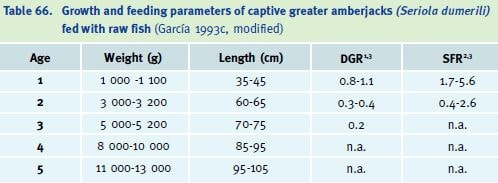
1 DGR = Daily growth rate (%).
2 SFR = Specific feeding rate (%).
3 Note: DGR and SFR vary with the seawater temperature.
In Japan, farmers use the same diets for feeding fry, fingerlings and adults of all yellowtail species. “Mojako” are fed ad libitum or at 80% of satiation. The feeding frequency is 8-10 times/day on stocking, 2-3 times/day later on, and 1-2 times/day later in the cycle; the daily quantity varies from 30% to 3% of body weight during the on-growing phase. FCRs of 7:1 are obtained with fish that weigh up to 1.5 kg, and 10:1 for fish up to 4 kg, based on a wet weight basis. On dry weight basis, the FCRs are 2.1:1 and 3.0:1 respectively (Pillay 1995).
Some farmers use anchovies, though this feed source is not recommended; continuous feeding with these fish can cause mortalities as a result of oxidation of the unsaturated fatty acids in anchovy flesh. The thiaminase contained in anchovy flesh has been found to cause vitamin B1 deficiency in yellowtail (Pillay 1995). The problem can be avoided if a vitamin mix consisting of vitamins B1, C and E is added to the diet to boost the vitamin B1 level and prevent oxidation and fat-deterioration (Nakada 2000). The use of sardines as the sole feed for yellowtail has also led to nutritional disorders caused by unsuitable protein and energy levels. Recommended calorie/protein ratios are shown in Table 67).
Until 1985, frozen raw fish were used in Japan as the main food in the culture of Japanese amberjack (S. quinqueradiata) (Nakada and Murai 1991; Shimeno 1991). The use of frozen fish alleviated deterioration of the feed and reduced environmental pollution. Its use did not cause any ill effects and was better than feeding thawed sardines. The body composition of sardines, especially the fat content, changes dramatically, depending on the season and harvest area. Its lipid content also differs between sardines caught in the Pacific Ocean and in the Sea of Japan. While a good system for distributing sardines has been developed, making them readily available to fish farmers, there is no control over their fat content. Sato et al. (Nisshin Nasu Feed Research Laboratory, unpublished data) found a high linear correlation between the moisture and fat contents of sardines landed at Kyushu, Sanin and Kushiro. The amount of moisture and fat in the bodies of sardines are highly negatively correlated (moisture and lipid equation in
Table 67. Recommended calorie/protein ratio by season and size for Japanese amberjacks (Nakada 2000, modified)
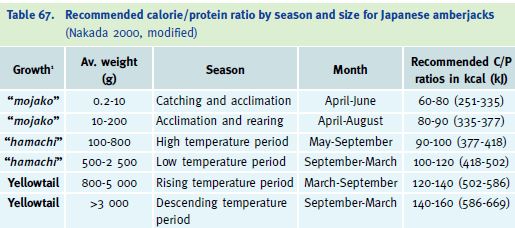
Catching and acclimation Acclimation and rearing High temperature period Low temperature period Rising temperature period Descending temperature period
1 These terms are defined in the first paragraph of this chapter.
sardines: y = -1.138x + 90.121; x is the moisture content, which ranges from 57-74%; y is the crude fat content, which ranged between 25.3-59%; n=35; ?=0.9702). Fat content can therefore be estimated by measuring the moisture content of the sardines rather than having to make a direct measurement of crude lipid. This provides an easier method for small-scale farmers (Nakada 2000).
Research is being conducted in Spain using moist and “soft-dry” pellets as feed for young S. dumerili; this has resulted in better growth, survival and FCR, than those achieved using raw fish (Garcia 2000).
In 1979, the Japanese Fisheries Agency started an important project to develop a moist pellet diet suitable for yellowtail culture. Its introduction failed until the early 1990s, because of the abundant and extremely cheap supply of domestic spot-lined sardine. However, fish farmers became aware of the severe damage to their environmental conditions that was the result of using trash fish instead of pellets. A new type of dry pellet diet that was produced in 1988, using extrusion machines, was found to be suitable for yellowtail culture (Nakada 2000). Figure 121 shows the amount of artificial feed used for yellowtail culture in Japan.
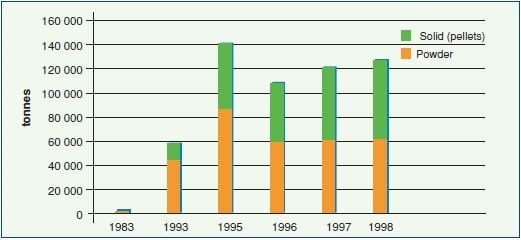
Figure 121. Total amount of artificial feeds used for Japanese amberjack culture in Japan (Nakada 2000, modified)
Several practical formulated feeds, e.g. the Oregon moist pellet (OMP), semi-moist pellets (SMP), “soft-dry” pellets (SDP), and extruded pellets (EP) have been developed; the latter two have only come recently into use. These formulated feeds have advantages and disadvantages. S. dumerili fed on OMP show lower mortality rates and more homogenous growth than those fed on raw fish (Di Bella, Genovese and Salvo 1991, 1994; Garcia 1993a,b; Greco et al. 1993; Garcia et al. 1995; Gonzalez et al. 1995); however, it is difficult to maintain the correct calorie-protein balance in larger pellets. At present the pellets do not supply enough energy for larger fish (Nakada and Murai 1991). However, this observation is recognized as being potentially out-dated since it is appreciated that extruded feed is now available for salmon, so the technology used for its production could be applied in the future to yellowtail feeds.
SMP have the same advantages as OMP, but in addition have stable nutritive values and are more hygienic, as they do not require fresh fish as a raw material. However, SMP cannot be used during periods of low temperature (Shimeno 1991).
SDP and EP have been successfully used in Japan, not only for the on-growing of S. quinqueradiata (Watanabe et al. 1991, 1992, 1993; Shimeno et al. 1993a,b,c,d,e; 1997b; Shimeno, Matsumoto and Ukawa 1997a), but also as a broodstock diet (Mushiake et al. 1995; Watanabe et al. 1996; Verakunpiriya et al. 1996, 1997). EP look very promising because they are cheaper, more nutritive, less polluting and require less labour and facilities for their preparation and storage (Nakada and Murai 1991; Shimeno 1991). EP formulations with crude lipid levels of more than 20% can be efficiently utilized by yellowtail. EP also have a high enough calorie content to meet the nutritional need of Seriola spp.; they are water stable, and do not deteriorate at normal temperatures, thus making possible the full-scale automatization of the capture-based aquaculture of yellowtail in offshore ocean sites (Nakada and Murai 1991). Yellowtail larger than 3 kg prefer raw fish to EP, however, and it is difficult to attain daily feeding rates of 2% with this type of feed, especially during winter. Nakada (2000) believes that the development of an extruded diet containing more than 25% lipid, and with pellets that weigh more than 30 g each, will be required for the economic production of yellowtail larger than 3 kg, especially during periods of low water temperature. Various feeding regimes and related production costs are shown in Tables 68 and 69.
During the 1980s in Japan it was common practice to add additional oils to feeds used in freshwater aquaculture, but the same oils could not be used for the marine species because there are significant differences in the fatty acid requirements of freshwater and marine species. Nakada (2000) developed suitable feed oils for marine species at the Aquafeed Division of the Nisshin Feed Co., Ltd. Commercial production trials with these oils produced yellowtail that had a similar lipid composition to wild fish. However, the quality of the oil containing high levels of HUFAs varied, so the Society of Aquaculture Feed Oil Investigation set up standards for feed oils recommended for aquaculture diets (Nakada 2000).
Table 68. Characteristics of the various types of feed used for different sizes of Japanese amberjack culture (Nakada 2000)
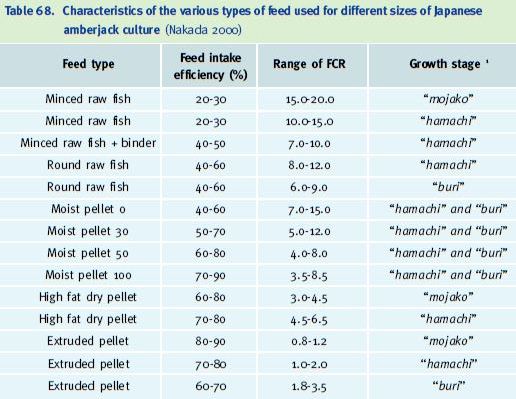
1 These terms are defined in the first paragraph of this chapter.
Owing to limitations that often affect the availability and sustainability of raw materials from marine sources, principally fishmeals and fish oils, the fish feed industry has undertaken extensive research into alternative raw materials that would meet requirements for the efficient cost-effective production of feed for farmed fish (Talbot 1998). Several papers have been published dealing with the partial substitution of fishmeal by other animal and plant protein sources in practical diets for S. quinqueradiata. Animal proteins from meat meal and meat and bone meal, together with plant proteins (mostly soybean meal but also corn gluten meal, rapeseed meal and malt protein flour) have been tested (Takii et al. 1990; Lee, Kang and Lee 1991; Shimeno 1991, 1992a,b, 1993a,b,c,d, 1997b; Shimeno, Matsumoto and Ukawa 1997a; Shimeno et al. 1995a,b; Masumoto et al. 1996; Ruchimat et al. 1997). In the future, it is expected that fishmeal, which is the main protein source in formulated feeds, will be substituted with soybean meal or poultry meal and a certain amount of fish oil will be added along with soybean oil or coconut oil (Nakada 2000).
Table 69. Feeding regimes and related production costs for yellowtails (Nakada 2000, modified)
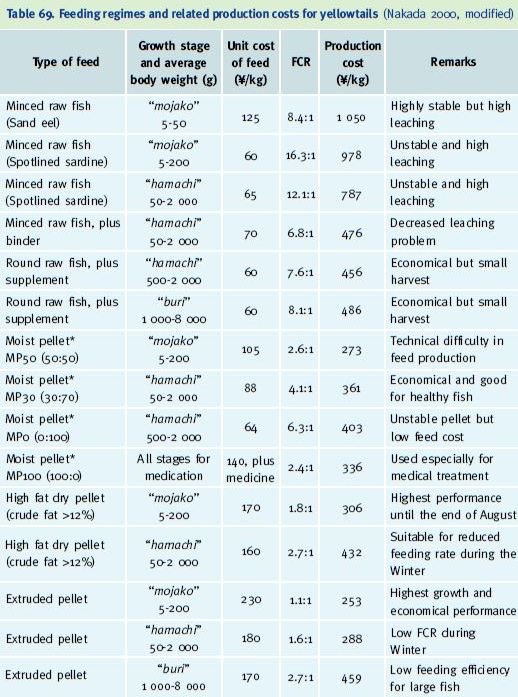
* Formulated powder (? 135/kg); Frozen sardines (? 60/kg); Feed oil (? 170/kg)